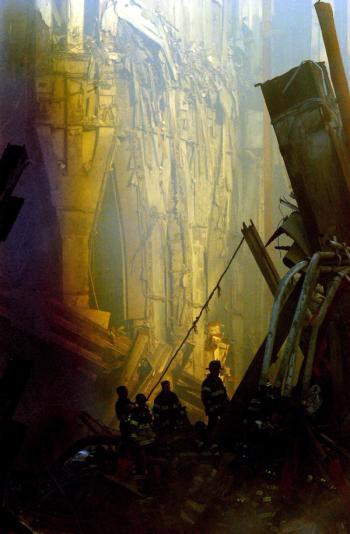
The Psychology of Guns: 12 Steps Toward More Safety
It is yet unclear whether the overwhelming shock of Newtown will galvanize action not only to prevent future mass murderers, but also to finally reduce the public health and mental health risks of more chronic, common, and routine gun violence in America.
It is sexy, it is satisfying, it is manly.
–Stanley McChrystal, retired US Army General,
When insight-oriented psychotherapy stalls, the therapist usually assumes that there are some powerful, often unconscious, forces opposing examination and change. Has there been a parallel process ever since the Martin Luther King, Jr, and Robert Kennedy assassinations prompted gun reform? It is yet unclear whether the overwhelming shock of Newtown (which I
Indeed, normal psychological processes may be partially responsible for this stagnation. It is easier to repress and dissociate individual and collective trauma, and “move on.” However, in the long term, as we see in PTSD in individuals, such trauma can continue to haunt us and limit what we can learn from history to prevent similar trauma in the future.
Guns in our history
Historically, guns have been in our nation’s collective consciousness. And, by guns, I mean not only handguns, pistols, and rifles, but possibly drones, missiles, torpedoes, and similarly shaped bombs.
At times, the choice of a particular type of gun could have psychological meaning. The Newtown mass murderer chose a .22 caliber rifle to shoot his mother, a student’s rifle with which his mother taught him to shoot.
The important role of firearms in the history, founding, and mythology of the United States is well accepted. Early on, that was concretized in the second amendment, though what that meant for future generations has been open to interpretation.
Later, guns were crucial for the “successful” expansion of our Western frontier. This kind of expansion was unprecedented in the world, other than perhaps the northern expansion of the Boers in South Africa.
In the last century, the US went on to become the strongest military power in the world. However, that power and security has been challenged more recently, with a draw in the Korean War, a somewhat humiliating withdrawal from Vietnam, and the missile-like airplane strike of 9/11, justifying to some a still-continuing War on Terrorism to reduce our vulnerability.
The meaning of guns
Concretely, guns are powerful weapons. Although there are certainly other weapons of violence-including hate speech, fists, knives, robbery, and oppression-guns, for better and worse, are the most certain, commonly available mode of killing or maiming others and/or oneself. That, too, must be part of our collective consciousness.
Furthermore, guns can have varying impact on a given individual’s consciousness. Advocates of guns for hunting and sport consciously view them as necessary for their pleasurable activities. Others view them as a source of safety and security, which would fulfill one of our most basic psychological needs, as described by the psychologist Abraham Maslow in his proposed hierarchy of psychological needs.
The unconscious meaning of guns may of course vary from individual to individual. Although some view their ideas as anachronistic, Freud and Jung offered some basic interpretations. For instance, in their shape, guns can be an obvious phallic symbol.
Freud emphasized our unconscious sexual and aggressive impulses, which seem readily applicable to guns. In his theory of the mind, the superego puts the brakes on id impulses for the sake of civilization. The superego is believed to be most affected by societal rules and the roles of the father (or father substitute). In the simplest terms, inconsistent rules weaken the superego. It can be further weakened in everyday life, if certain disinhibiting substances are abused. Whenever the rules are in fact to be aggressive and to use guns (as in war), the ego allows the superego to relax.
The hidden meaning of guns seems reflected in our language. Language, such as “top gun,” “young gun,” and “stick to your guns,” seems to glorify guns, and by association, their users. In terms of the mentally ill-whom the NRA blames for gun violence-the worst term may be “go ballistic.” “Ballistic” refers both to the science of projectiles and to being irrational.
If we add on, in a Jungian sense, our collective unconscious, guns may be ingrained as an archetype of the heroic (usually male) warrior. This archetype may be reinforced as a model for soldiers, police, and even gang leaders. Unfortunately, sometimes would-be warriors can go astray as the shadow archetype, sort of like the dark force of Darth Vader.
If such Jungian speculation isn’t enough, we can go further out on a psychological limb. How do we explain a kind of societal suicidal behavior when we allow ourselves such easy access to the most accessible mechanism to kill? Masochism stemming from unconscious guilt? Unconscious guilt over slavery, Native Americans, and Vietnam atrocities?
The psychological damage of guns
The psychological effects of guns may go well beyond what some would call a normal degree of security, belonging, freedom, self-esteem, and power. It can go well beyond those killed, to the ripple effects on those physically and psychologically injured, or even just threatened, by guns.
There is the grief, normal and abnormal, of the loved ones of those killed by guns. There is the potential PTSD of those not killed, but injured by guns. There is the potential PTSD of those witnessing the violence, so common in public places. Self-medicating for these psychological wounds is common, but has the potential drawback of disinhibiting barely controlled anger. I experienced all of these, often in a prison setting, where below the bravado lay the pain of childhood exposure to violent trauma, often gun-related, especially in African-American males, released in crime and/or substance abuse.
The gun industry
It sure seems like the gun development and advertising industry has taken advantage of these psychological associations, as described in the
The AR-15-style automatic rifle, used in the Newtown school massacre, has become the most popular gun in America. It is a version of the military M-16. By design, it looks and feels like something a gun a commando would carry. For its power and reliability, one ad exclaims, “Forces of opposition, bow down.”
After an interesting sales drop following the Vietnam War, the response by gun makers was to advertise the AR-15 for men, and to begin to advertise handguns for women. More recently, the ease in customizing guns to one’s own psychology, including a “southpaw’s dream” for left-handers like me, made them a sort of “Legos for guys.” Fashionable colors, like pink, increased the popularity of guns for women. The meaning of subliminal messages that might be encoded in ads, perhaps like the phallic images in cigarette ads, needs more scrutiny.
Guns in the media
The successful advertising for guns has been supplemented by the game industry, television, comic books, and movies. Research is inconclusive as to whether increasing exposure to violence in the media in turn increases real-life aggression, or whether for many, they are a sublimation and displacement that actually reduces real-life aggression. Instead of increased violence, could they instead increase anxiety, a possibility not well researched?
What is clear is that guns portray an image of power, which may be especially attractive to adolescent males, at a time when boys are falling more behind girls in school, and more women take jobs previously dominated by males (including now the right to serve in combat).
Guns in my family
Now I can't tell you whether there are any guns in our house. However, it always seemed to me-and research has come to support this conclusion-that any possible defensive use of guns by someone not expert in their use, has a greater chance to backfire, so to speak. Then again, we’ve generally lived in safe areas. Being isolated from gun violence is a blessing in one sense, but allows less concern for the problem.
I did, though, learn to shoot a gun, sort of, in the orientation we new physicians had in the army many years ago. What an unsettling experience! Doctors devoted to saving lives trying to hit a target with a bullet. We were told that someday we may need to use them to save a life, even our own.
While I struggled to write this blog, accompanied by Barber’s “Adagio for Strings,” I went into the kitchen for a change of scenery, where my visiting grandson was playing with an old, long Nintendo gun in a kind of hunting game. He asked, “Hey-hey (the name he gave me), are you writing a blog on guns?” Now, I’m no longer easily surprised by what my grandchildren know about me-but how did he know this?
I also wondered, was this game appropriate for our 10-year-old grandson, who coincidentally was just starting to become interested in girls? My wife reminded me that our son used this same game, and he became a rabbi. I was freed to continue writing.
What psychiatrists can do
As citizens, we can fully participate in the debates about how to address gun control and safety. It would be interesting to conduct an anonymous poll to see what mental health professionals believe as far as prospective changes and whether we have our own guns, and why? For physicians, who are devoted to preserving life and promoting the best health possible, advocating against any unnecessary guns for self-defense seems ethically self-evident. AR-15s would seem to be way more than necessary for any personal self-defense situation.
Beyond that, our particular psychological expertise can be applied in ways, including these bullet points:
(1) Educate the public about the psychology of guns, even as speculative as some of it may be
(2) Investigate further the psychology of guns
(3) Educate the public that, although we are not particularly skilled at predicting homicide or suicide, we are much better at treating the mental health conditions that, if left untreated, might lead to a certain small percentage of fatal gun violence
(4) Case find, whether in schools or emergency rooms, those who have been injured or exposed to gun violence, for they will be more prone to later PTSD and/or risky self-medicating
(5) Support preventive services that teach children nonviolent ways to handle frustration and anger
(6) Advocate for improved mental health resources, particularly for child, adolescent, and family therapy, as well as other services that will help maintain a healthy nuclear family
(7) Follow-up on the mental healthcare needs of known bullies and victims of bullying
(8) Clinically, be sure to promote safety as part of the evaluation template, including whether guns are at home and for what overt (and covert) purpose
(9) Appreciate the appropriate use of psychopharmacology for symptoms of undue aggression, such as propranolol, and avoid prescribing disinhibiting medication, such as benzodiazepines
(10) Hospitalize, when necessary. Hospitalization needs to be available for long enough to reduce significantly any suicide and/or homicide risk
(11) Remind politicians that improved gun control and safety will dramatically reduce successful suicide attempts, as well as reduce violence commonly perpetrated against the mentally ill
(12) To the extent that our professional tradition has been based on the therapeutic use of words and language, apply that skill to gun-associated language
Ultimately, it may take women, who are increasingly buying guns and now have the right to fight in military combat, to break up this male-dominated gridlock. A model for this might be Mothers Against Drunk Driving (MADD), which addresses another societal problem of some similarity to gun violence. Here, mothers seemed to adapt cognitive behavioral therapeutic principles to change the culture of driving while intoxicated. Is now the time, then, for WAGG-Women Against Gun Glorification?
References:
References
1. Rose G. Generation kill: a conversation with Stanley McChrystal. Foreign Affairs. March/April 2013.
2. Moffic S. Mass murderers and psychiatry. Psychiatr Times. December 17, 2012.
3. Singer N. The most wanted gun in America. New York Times. February 2, 2013.
Newsletter
Receive trusted psychiatric news, expert analysis, and clinical insights — subscribe today to support your practice and your patients.

















